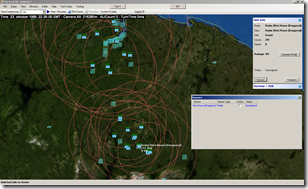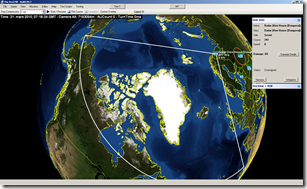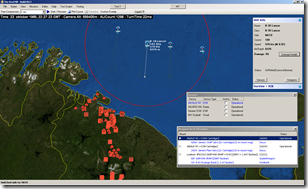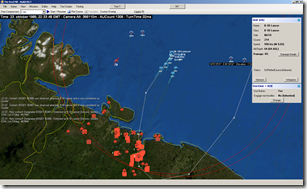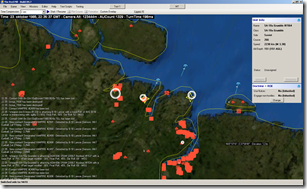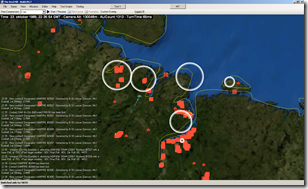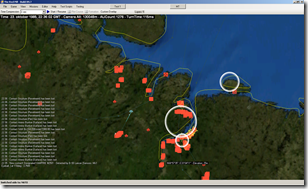Aimpoints in Red Pill
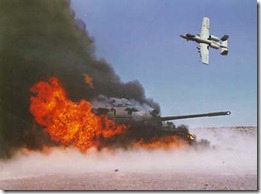 One of the posters at the Red Pill forum had a question related to the modeling of discrete vehicles/aimpoints. I considered it useful to have the response repeated here since it is an important new feature for Red Pill and a sore spot of the air/nav wargaming community for years now.
One of the posters at the Red Pill forum had a question related to the modeling of discrete vehicles/aimpoints. I considered it useful to have the response repeated here since it is an important new feature for Red Pill and a sore spot of the air/nav wargaming community for years now.
Q: Are Land Units simulated down to single vehicles and posts? Is a SAM battalion or Tank platoon just a single large target that can be zapped with a single weapon as long as its deals enough damage or are its parts actually modeled, both for damage calculation and positioning on the map?
A: Yes, mobile formations (and selected facilities) are modeled as containers of discrete vehicles or aimpoints, and each of them needs to be independently destroyed. No more wiping out a tank platoon with a single LGB.
Each of the vehicles/aimpoints is also evaluated separately for blast resistance on proximity explosions. So for example if you drop a bomb on that tank platoon it may impact close enough to one or two of them to damage or destroy them, but most of the others are likely to be far enough that they’ll shrug it off (typical vehicle/aimpoint dispersion distance depends on the nature of the unit/facility). This of course varies with target type & hardness; drop that same bomb on a truck section and you may well get multiple kills.
Vehicle/troop/aimpoint dispersion in Red Pill really makes cluster warheads meaningful again (aside from the nice visual effect). You can drop a very powerful unitary HE warhead on a vehicle group and get disappointingly few kills (particularly if they are armored); drop an equivalent amount of cluster munitions on it and maybe you will wipe it out altogether.
The same holds true for other area-effect warhead types such as FAE or incendiary. (And of course nukes).
Red Pill screenshots #5: Kola nuclear strike!
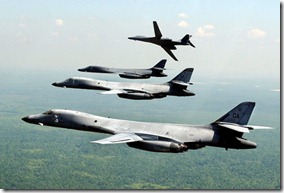 As part of his beta-testing of Red Pill, he has been porting over some of his classic H3 creations and running them on the new air/naval wargame. Following is his photo-AAR of one such scenario, featuring a nuclear strike on the Kola Peninsula. Editor’s comments in Italic!
As part of his beta-testing of Red Pill, he has been porting over some of his classic H3 creations and running them on the new air/naval wargame. Following is his photo-AAR of one such scenario, featuring a nuclear strike on the Kola Peninsula. Editor’s comments in Italic!
————————————————————————————–
23th October 1985:
The war has not gone well for the Soviets. After five weeks of fighting, a stalemate had ensued on the Central Front. The tables were turning and NATO was able to launch its first major counteroffensive. Although facing stiff opposition, once the offensive gathered momentum, NATO troops advanced up to 20 kilometers per day in some areas. The Soviets, with the near collapse of their military logistical effort and with their frontline ammo stocks running low, had no choice but to give ground and fall back.
There has been a considerable amount of war termination negotiations in the last few days. But a settlement to the war seems virtually impossible to attain. It is unthinkable for the Soviets to give up what they have fought so hard for, and they insist on a cease-fire that recognizes their territorial gains. NATO, on the other hand, is unwilling to recognize any Soviet gains and calls for a return to status quo ante bellum.
The Soviets are strongly seeking a decisive military and political result before the industrial might of the West can be mobilized. However, having failed to destroy NATO in a short war, the Soviets are unlikely to regain a conventional military advantage. Facing total defeat in the Central European theater, the Soviets would eventually be forced to choose between surrender and escalation. To retrieve the losing situation, a decision was made to launch a limited nuclear and chemical attack on NATO front-line units. 44 missile-delivered 5-20kT nuclear warheads and a dozen persistent chemical agent warheads were employed against NATO troops in the most hard-pressed areas.
The NATO response was swift. 49 nuclear warheads were detonated over Soviet frontline units, four army garrisons, five air bases and two rail yards. NATO announced this as a one-time strike in retaliation for the Soviet attack. The Soviets struck back with a volley of theater ballistic missiles targeting eight NATO air bases, three ports of disembarkation in the Netherlands and France, as well as key command, control and communication facilities (C3) and several storages for nuclear weapons. NATO responded by employing nuclear warheads against another ten Soviet air bases in Germany, Poland and Czechoslovakia, four major naval bases in East Germany and around Kaliningrad, several nuclear weapon storage sites, C3 nodes, and logistical centers.
The situation was now fast spiraling out of control, and the war was rapidly escalating towards a strategic-scale exchange. The Soviets issued a warning via the hotline that they would not tolerate further American nuclear aggression on the Central Front, and launched no less than six single-warhead SLBMs at the naval facilities at Norfolk.
NATO had a difficult time settling on an appropriate target for retaliation due to the risk of causing a dramatic escalation. But in order to shock the Soviets into realizing the seriousness of NATO’s resolve, it was decided to launch a limited nuclear attack on the Kola Peninsula, the Soviet Union’s most concentrated naval base complex. It is hoped this operation, combined with a threat of general SIOP release, can force the Soviets to return to the negotiating table with a different attitude.
The Soviet Union during the last thirty years has transformed the Kola Peninsula into the world’s most complex and concentrated naval base. The majority of the Soviet SSBNs are based here, and the Red Banner Northern Fleet is the Soviet Union’s most formidable fleet. In addition the Kola Peninsula has sixteen major military airfields. Most of them are not used daily but were rapidly made operational in the days leading up to war. It is estimated the Soviets currently have about 350 aircraft of all categories (including multiple regiments of Badger & Backfire bombers) based on the peninsula. The air defense forces consist of MiG-23, MiG-31 and Su-15 interceptors supported by ground-based radars and AWACS aircraft. The air defense ground element is made up of about fifty fixed SAM sites and numerous mobile batteries.
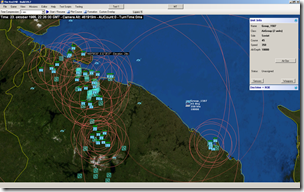
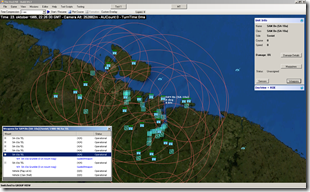
The Red Pill guys are known for their thorough research, and the SAM sites in this scenario are placed at their real-life 1985 locations. This includes the six SA-10a Grumble battalions (S-300PT-1 with improved 5V55KD missiles), the first of which went on combat duty in September 1985.
All major installations have been implemented on a discrete per-component basis, i.e. all hardened shelters, revetments, tarmacs, ammo bunkers, fuel bunkers, piers, major buildings etc., have true-to-life coordinates.
(Ed: This was in fact quite simple to achieve. As previously mentioned, Red Pill’s scenario editor has tools designed specifically to make it easy to construct highly detailed installations with pinpoint accuracy of facilities and then re-use them on different scenarios.)
In addition to the bases, the Kola Peninsula hosts a massive Hen House radar for detecting ballistic missiles. It is protected by a triangle of paired SA-2 and SA-3 sites plus a dedicated SA-5 site with three launcher battalions.
The NATO strike is made up of eight B-1B bombers carrying 48 nuclear warheads. Six of the bombers are armed with four B83 megaton-class nuclear bombs each, while another two will be armed with eight SRAM missiles in addition to their four B83 bombs. The SRAMs will be employed against the Murmansk SA-5 site, suspected SA-10 sites and the Kilpyavr PVO interceptor base.
(Ed note: Notice the “Doctrine & ROE” option, a new feature that enables automatically fine-tuning a unit’s behavior depending on its side, mission or group membership. This makes it *a lot* easier to customize the AI’s combat behavior.)
Soviet MiG-31s from Monchegorsk and MiG-23s from Kilpyavr are rushing to intercept the B-1Bs. The bombers’ ALQ-161 defensive suites are working overtime to jam the incoming AA-9 missiles. 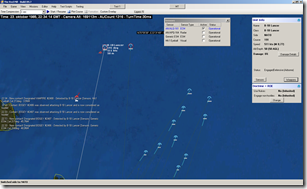
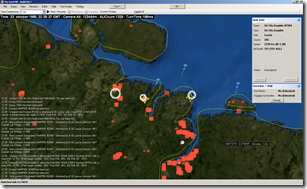
A B-1B eats an AA-9 just as the first SRAM salvo strikes home. Note the shock waves from the nuclear explosions.
(Ed note: Initially we considered making the blast circles soild white, to match the “WarGames” look. But it was correctly pointed out that this may make it difficult to view & pick out units inside the blast circle, so we opted to represent them as an expanding wave instead.)
Another two B-1Bs are downed by volleys of AA-9s, AA-6s and AA-7s. The remaining five B-1Bs press on at max speed! 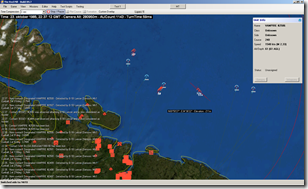
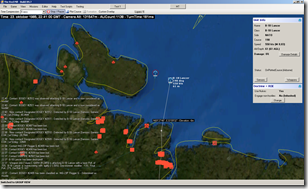
The B-1B to the west lays down B83s across three submarine bases and an airbase while a second B-1B closes on Polyarny and Severemorsk with a pair of MiG-31 in fast pursuit. All eight nuclear bombs detonate successfully, destroying no fewer than six naval bases and two air bases. Note the detonation delay for the parachute-retarded B83s.
(Ed note: New feature here as well – anti-surface weapons in general and nukes in particular can be set to detonate after a short delay in order to allow the unit that dropped them to clear the blast zone.)
Meanwhile, to the east, the second of the two B-1Bs headed for the Gremikha submarine is intercepted and killed by a pair of MiG-31s.


A pair of B-1Bs are closing on the Olenegorsk bomber base, the Hen House BMEWR, Monchegorsk PVO interceptor base, and five other airfields in central Kola. The southernmost B-1B is seconds from being hit by no fewer than six SA-2, SA-3 and SA-5s. A total of five out of eight B-1Bs have been lost thus far. 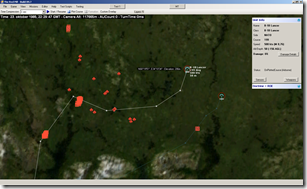
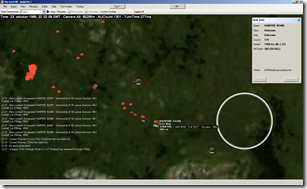
The Hen House radar dies. The Olenegorsk base, home of a regiment for Tu-16 naval bombers, will take a B83 next (note the CEP calculations!), followed by Monchegorsk and Afrikanda. 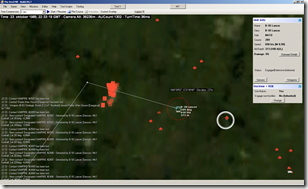
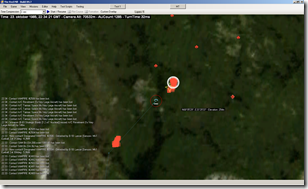
Overall and despite the heavy bomber losses, the strike was highly successful: 70% of the strategic bases on Kola were laid to waste. Sixteen SRAMs and fifteen B83s were successfully employed at the cost of 5 B-1B bombers.
OT: About “Bar Stool Economics”
Here’s a popular chain mail that’s been making the rounds for about a decade now. If you recognize it, jump ahead for the real good stuff.
Bar Stool Economics
Suppose that every day, ten men go out for beer and the bill for all ten comes to $100. If they paid their bill the way we pay our taxes, it would go something like this:
The first four men (the poorest) would pay nothing.
The fifth would pay $1.
The sixth would pay $3.
The seventh would pay $7.
The eighth would pay $12.
The ninth would pay $18.
The tenth man (the richest) would pay $59.So, that’s what they decided to do.
The ten men drank in the bar every day and seemed quite happy with the arrangement, until on day, the owner threw them a curve. “Since you are all such good customers,” he said, “I’m going to reduce the cost of your daily beer by $20.”Drinks for the ten now cost just $80.
The group still wanted to pay their bill the way we pay our taxes so the first four men were unaffected. They would still drink for free. But what about the other six men – the paying customers? How could they divide the $20 windfall so that everyone would get his ‘fair share?’ They realized that $20 divided by six is $3.33. But if they subtracted that from everybody’s share, then the fifth man and the sixth man would each end up being paid to drink his beer. So, the bar owner suggested that it would be fair to reduce each man’s bill by roughly the same amount, and he proceeded to work out the amounts each should pay.
And so:
The fifth man, like the first four, now paid nothing (100% savings).
The sixth now paid $2 instead of $3 (33%savings).
The seventh now pay $5 instead of $7 (28%savings).
The eighth now paid $9 instead of $12 (25% savings).
The ninth now paid $14 instead of $18 (22% savings).
The tenth now paid $49 instead of $59 (16% savings).Each of the six was better off than before. And the first four continued to drink for free. But once outside the restaurant, the men began to compare their savings.
“I only got a dollar out of the $20,”declared the sixth man. He pointed to the tenth man,” but he got $10!”
“Yeah, that’s right,” exclaimed the fifth man. “I only saved a dollar, too. It’s unfair that he got ten times more than I!”
“That’s true!!” shouted the seventh man. “Why should he get $10 back when I got only two? The wealthy get all the breaks!”
“Wait a minute,” yelled the first four men in unison. “We didn’t get anything at all. The system exploits the poor!”
The nine men surrounded the tenth and beat him up.
The next night the tenth man didn’t show up for drinks, so the nine sat down and had beers without him. But when it came time to pay the bill, they discovered something important. They didn’t have enough money between all of them for even half of the bill!
And that, boys and girls, journalists and college professors, is how our tax system works. The people who pay the highest taxes get the most benefit from a tax reduction. Tax them too much, attack them for being wealthy, and they just may not show up anymore. In fact, they might start drinking overseas where the atmosphere is somewhat friendlier.
David R. Kamerschen, Ph.D.
Professor of Economics
University of GeorgiaFor those who understand, no explanation is needed. For those who do not understand, no explanation is possible.
First off, a quick lookup at Snopes reveals that the article attribution is false.
Second, I am suspicious in general of simplistic internet memes and this one in particular seemed to be quite loaded with its agenda. Not being an economist, I browsed around for reasonable criticism. And found this gem:
Gosh oh gee. How do I debate such a straight forward and simple explanation of our tax system?
Let me try.
A “real” economist would have two problems with this “example”:
1. It uses luxury as its model. A simple understanding of game theory shows that at the end of the story, if the 10th man decides not to buy, then he has no leverage. No one “needs” beer. Our government doesn’t apportion luxuries.
2. There is no baseline. The assumption is that if you can’t afford it, don’t drink. When in reality, what most of us are doing is working to pay for food, clothing, shelter, education, and healthcare. THAT is the baseline. Anything made above the price of these necessities could be subject to the “beer” argument, but the result would end up with pretty much everyone paying as shown.
So it’s ridiculous to use beer as the example. Why not use 60″ plasma TVs or diamonds? None of these represent the economic situation that most of us find ourselves in. Since the example uses a luxury (beer) as its foundation, let’s rewrite the story using a necessity: Oxygen.
HERE IS THE UPDATE TO THE STORY
Suppose that every day, ten men go out for oxygen and the bill for all ten comes to $100. It would go something like this:
The first four men (the poorest) would pay nothing.
The fifth would pay $1.
The sixth would pay $3.
The seventh would pay $7.
The eighth would pay $12.
The ninth would pay $18.
The tenth man (the richest) would pay $59.
So, that’s what they decided to do.
The ten men breathe each day and seem quite happy with the arrangement, until one day, the richest man throws them a curve.
“I’m tired of paying the most when you all use the same amount of oxygen. I’m not going to pay for you to get oxygen anymore. Go buy your own air.”
the 1st and 2nd men (poorest) can’t afford oxygen and die within minutes.
The 3rd poor man gets his wages reduced by his boss (the seventh man who needs to pay more now) and can no longer afford oxygen either. He dies within days.
The 4th poor man, pays for oxygen and continues to breathe. How? He loves his wife and kids and so to continue to allow them to breathe, he was driven to steal the rich man’s car to pay for oxygen for his family. Crime increases, not because men want “beer” and bling, but because they will do anything to provide for their families. He gets caught and sent to prison where he earns no money. His disabled wife and small children all die now that they have no provider of oxygen.
The 5th & 6th men make their living selling products (like food) and services to the first 4 men. Having more than half of their customers die, they can no longer afford to stay in business. They both close shop and die within weeks.
The 7th & 8th men own or work for companies that sell products and services to the 9th & 10th man. Unfortunately, the workers they rely on to plant and harvest the crops, manufacture goods, and deliver the services have all died. Within months, the 7th and 8th men die.
The 9th man has enough money to buy oxygen for a year. Unfortunately, the guy that refills oxygen bottles was man number 1. The guy that maintains the regulators and oxygen safety equipment was man number 2. The owner of the trucking company that delivers the oxygen was man number 7. Man number 9 dies in 4 months when the supply of safe, available oxygen disappears.
Now we come to good, ol’ man number 10. The guy that wants to stop paying because he is blind to the value others bring to him and his lifestyle.
Man number 10 has stocked away 5 years worth of oxygen. He’ll survive…at least for awhile. As long as he can build his own roads, make his own electricity, maintain his own equipment, grow his own food, provide his own healthcare, clean his own air & water, and protect himself from fire, flood, hurricane, and the occasional attack from anyone else who might have survived and wants to take HIS oxygen.
And that, ladies and gentlemen, journalists and college professors, is how our tax system would work if we let the short-sighted run our economy. The people who pay the highest taxes need to understand that they truly get the most benefit when the people who supply, buy, and work for them can afford the necessities of life.
Bitch too much, attack the middle class and poor for not paying enough, and they just may stop producing, showing up, or DIE.
David Stuck
Student of Life and Economics
For those who were naive enough to accept the “beer” analogy, think about where YOUR money goes and what would happen to you. (hint: You aren’t the 10th man)
http://davestuck.blogspot.com/2008/10/for-over-year-now-bar-stool-economics.html




